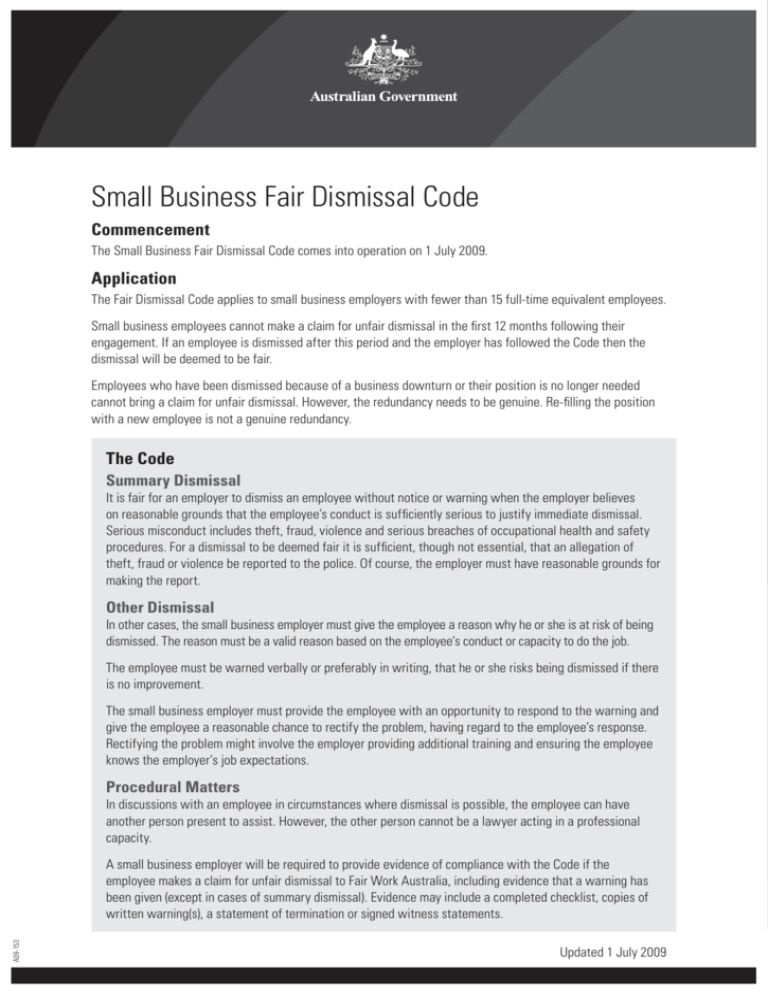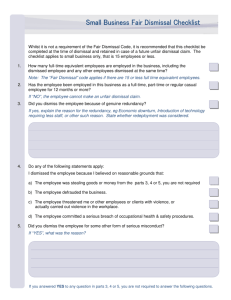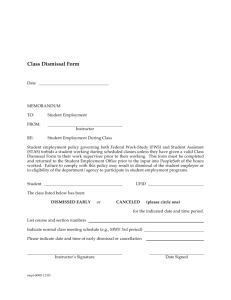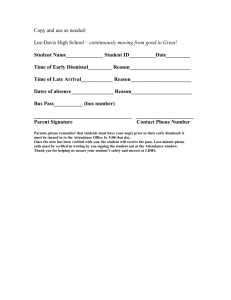Small Business Fair Dismissal Code + Checklist
advertisement

Small Business Fair Dismissal Code Commencement The Small Business Fair Dismissal Code comes into operation on 1 July 2009. Application The Fair Dismissal Code applies to small business employers with fewer than 15 full-time equivalent employees. Small business employees cannot make a claim for unfair dismissal in the first 12 months following their engagement. If an employee is dismissed after this period and the employer has followed the Code then the dismissal will be deemed to be fair. Employees who have been dismissed because of a business downturn or their position is no longer needed cannot bring a claim for unfair dismissal. However, the redundancy needs to be genuine. Re-filling the position with a new employee is not a genuine redundancy. The Code Summary Dismissal It is fair for an employer to dismiss an employee without notice or warning when the employer believes on reasonable grounds that the employee’s conduct is sufficiently serious to justify immediate dismissal. Serious misconduct includes theft, fraud, violence and serious breaches of occupational health and safety procedures. For a dismissal to be deemed fair it is sufficient, though not essential, that an allegation of theft, fraud or violence be reported to the police. Of course, the employer must have reasonable grounds for making the report. Other Dismissal In other cases, the small business employer must give the employee a reason why he or she is at risk of being dismissed. The reason must be a valid reason based on the employee’s conduct or capacity to do the job. The employee must be warned verbally or preferably in writing, that he or she risks being dismissed if there is no improvement. The small business employer must provide the employee with an opportunity to respond to the warning and give the employee a reasonable chance to rectify the problem, having regard to the employee’s response. Rectifying the problem might involve the employer providing additional training and ensuring the employee knows the employer’s job expectations. Procedural Matters In discussions with an employee in circumstances where dismissal is possible, the employee can have another person present to assist. However, the other person cannot be a lawyer acting in a professional capacity. A09-153 A small business employer will be required to provide evidence of compliance with the Code if the employee makes a claim for unfair dismissal to Fair Work Australia, including evidence that a warning has been given (except in cases of summary dismissal). Evidence may include a completed checklist, copies of written warning(s), a statement of termination or signed witness statements. Updated 1 July 2009 Small Business Fair Dismissal Code Checklist It is in the interests of the employer to complete this checklist at the time of dismissal and to keep it in case of a future unfair dismissal claim. However, it is not a requirement of the Fair Dismissal Code that the checklist be completed. 1. How many full-time equivalent employees are employed in the business? (Include the dismissed employee and any other employee dismissed at the same time). Under 15 full-time equivalent employees 15 full-time equivalent employees or more [If under 15 full-time equivalent employees, the Fair Dismissal Code applies.] 2. Has the employee been employed in this business as a full-time, part-time or regular casual employee for 12 months or more? Yes No [If No, the employee cannot make an unfair dismissal claim.] 3. Did you dismiss the employee because of a genuine redundancy? Yes No If Yes, explain the reason for the redundancy (for example, economic downturn, introduction of new technology therefore requiring less staff, or another such reason) and whether redeployment was considered. 4. Do any of the following statements apply? I dismissed the employee because I believed on reasonable grounds that: YES NO a. The employee was stealing money or goods from the business. b. The employee defrauded the business. c. The employee threatened me or other employees, or clients, with violence, or actually carried out violence in the workplace. d. The employee committed a serious breach of occupational health and safety procedures. Updated 1 July 2009 5. Did you dismiss the employee for some other form of serious misconduct? Yes No If Yes, what was the reason? If you answered Yes to any question in parts 3, 4 or 5, you are not required to answer the following questions. 6. Did you dismiss the employee because of the employee’s unsatisfactory conduct, performance or capacity to do the job? Yes No If Yes YES NO c. Did you offer to provide the employee with any training or opportunity to develop his or her skills? d. Did the employee subsequently improve his or her performance or conduct? a. Did you clearly warn the employee (either verbally or in writing) that the employee was not doing the job properly and would have to improve his or her conduct or performance, or otherwise be dismissed? b. Did you provide the employee with a reasonable amount of time to improve his or her performance or conduct? If yes, how much time was given? e. Before you dismissed the employee, did you tell the employee the reason for the dismissal and give him or her an opportunity to respond? f. Did you keep any records of warning(s) made to the employee or of discussions on how his or her conduct or performance could be improved? Please attach any supporting documentation. Updated 1 July 2009 7. Did you dismiss the employee for some other reason? Yes No If Yes, what was the reason? 8. Did the employee voluntarily resign or abandon his or her employment? Yes No If Yes, please provide details DECLARATION I declare that I believe every statement or response in this checklist to be true. Signature Date Updated 1 July 2009





